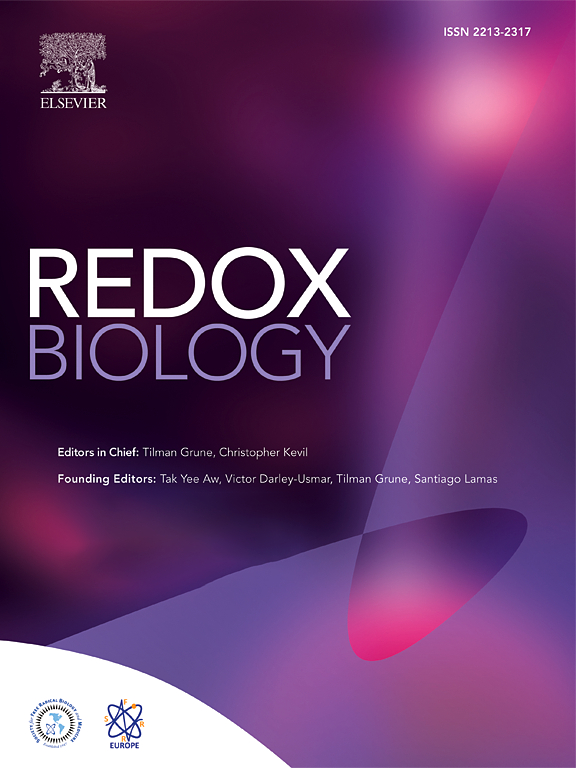Metabolic analysis of sarcopenic muscle identifies positive modulators of longevity and healthspan in C. elegans
IF 10.7
1区 生物学
Q1 BIOCHEMISTRY & MOLECULAR BIOLOGY
引用次数: 0
Abstract
Sarcopenia is the age-related degeneration of skeletal muscle, resulting in loss of skeletal muscle tone, mass, and quality. Skeletal muscle is a source of systemic metabolites and macromolecules important for neuronal health, function, and healthy neuronal aging. Age-related loss of skeletal muscle might result in decreased metabolite and macromolecule availability, resulting in reduced neuronal function or increased susceptibility to unhealthy aging and neurodegenerative diseases. We aimed to identify muscle metabolite candidates that regulate healthy aging. C57BL/6J mice were aged to young adult (4 months) and old age (25 months) and skeletal muscle was collected. Age-related muscle loss was confirmed by reduced muscle mass, muscle fiber degeneration, reduced myosin intensity, in addition to a metabolic shift and increased DNA damage in skeletal muscle. Using a low molecular weight enriched metabolomics protocol, we assessed the metabolic profile of skeletal muscle from young adult and old age mice and identified 20 metabolites that were significantly changed in aged muscle. These metabolite candidates were tested in C. elegans assays of lifespan, healthspan, muscle, and mitochondrial morphology under normal and stressed conditions. We identified four metabolite candidates (beta-alanine, 4-guanidinobutanoic acid, 4-hydroxyproline, pantothenic acid) that, when supplemented in C. elegans provided robust gero- and mitochondrial protection. These candidates also affected life-, and health- span in C. elegans models of amyotrophic lateral sclerosis (ALS) and Duchenne muscular dystrophy (DMD). Our findings support that aging muscle can be used to identify novel metabolite modulators of lifespan and health and may show promise for future treatments of neurodegenerative and neuromuscular disorders.
肌肉减少肌肉的代谢分析确定秀丽隐杆线虫的寿命和健康寿命的积极调节因子
骨骼肌减少症是与年龄相关的骨骼肌退化,导致骨骼肌张力、质量和质量的丧失。骨骼肌是对神经元健康、功能和健康的神经元衰老至关重要的全身代谢物和大分子的来源。与年龄相关的骨骼肌丧失可能导致代谢物和大分子可用性降低,导致神经元功能降低或对不健康衰老和神经退行性疾病的易感性增加。我们的目标是确定调节健康衰老的肌肉代谢物候选物。将C57BL/6J小鼠衰老至青年(4个月)和老年(25个月),采集骨骼肌。年龄相关的肌肉损失可以通过肌肉质量减少、肌纤维变性、肌球蛋白强度降低、代谢变化和骨骼肌DNA损伤增加来证实。使用低分子量富集代谢组学方案,我们评估了年轻成年小鼠和老年小鼠骨骼肌的代谢谱,并鉴定出20种代谢物在老年肌肉中发生了显著变化。这些代谢物候选物在正常和应激条件下的秀丽隐杆线虫的寿命、健康寿命、肌肉和线粒体形态分析中进行了测试。我们确定了四种代谢物候选物(β -丙氨酸,4-胍丁酸,4-羟基脯氨酸,泛酸),当在秀丽隐杆线虫中补充时,它们提供了强大的基因和线粒体保护。这些候选者也影响了秀丽隐杆线虫肌萎缩性侧索硬化症(ALS)和杜氏肌营养不良症(DMD)模型的寿命和健康寿命。我们的研究结果支持衰老肌肉可以用来识别寿命和健康的新型代谢物调节剂,并可能为神经退行性疾病和神经肌肉疾病的未来治疗带来希望。
本文章由计算机程序翻译,如有差异,请以英文原文为准。
求助全文
约1分钟内获得全文
求助全文
来源期刊

Redox Biology
BIOCHEMISTRY & MOLECULAR BIOLOGY-
CiteScore
19.90
自引率
3.50%
发文量
318
审稿时长
25 days
期刊介绍:
Redox Biology is the official journal of the Society for Redox Biology and Medicine and the Society for Free Radical Research-Europe. It is also affiliated with the International Society for Free Radical Research (SFRRI). This journal serves as a platform for publishing pioneering research, innovative methods, and comprehensive review articles in the field of redox biology, encompassing both health and disease.
Redox Biology welcomes various forms of contributions, including research articles (short or full communications), methods, mini-reviews, and commentaries. Through its diverse range of published content, Redox Biology aims to foster advancements and insights in the understanding of redox biology and its implications.
 求助内容:
求助内容: 应助结果提醒方式:
应助结果提醒方式:


